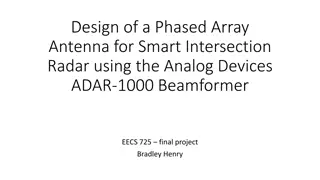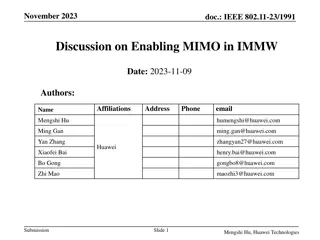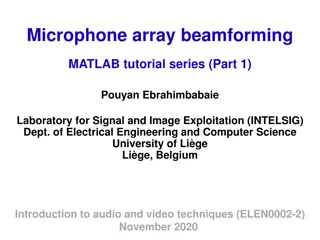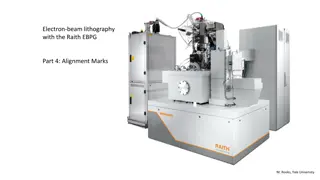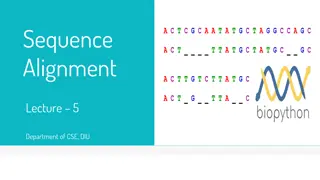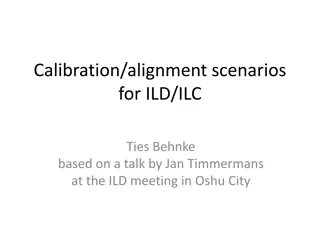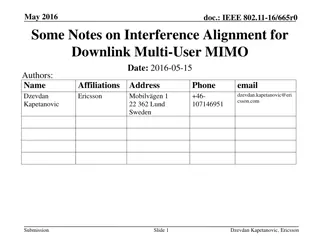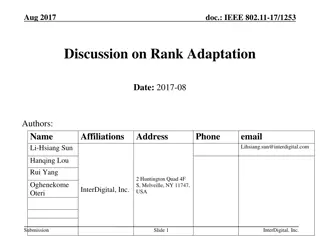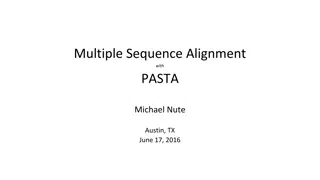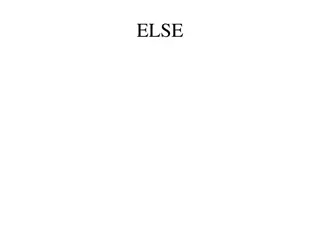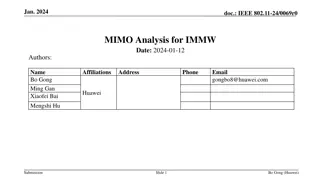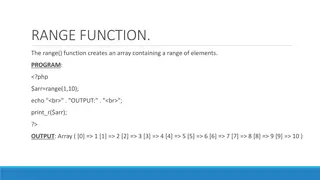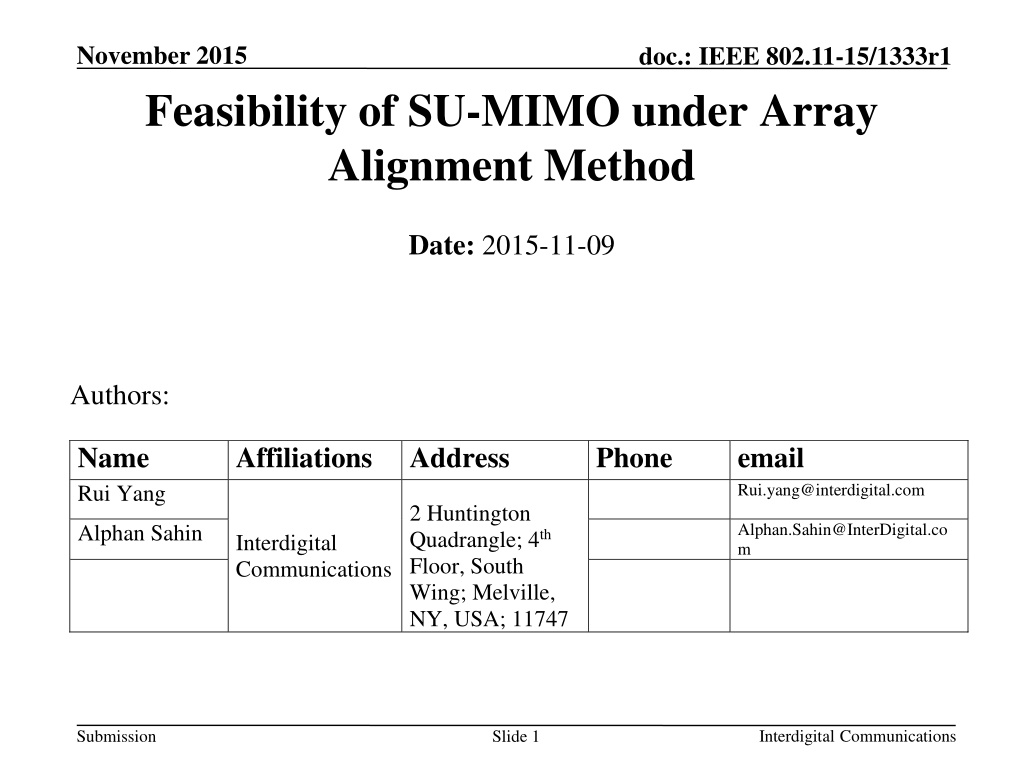
Feasibility of SU-MIMO Under Array Alignment Method
Investigate the feasibility of Single-User Multiple-Input Multiple-Output (SU-MIMO) using array alignment method based on channel models adopted in IEEE 802.11 standards. Simulation methodology proposed for evaluating performance in an IEEE 802.11ay environment, analyzing factors such as MIMO channel condition number, achievable capacity, and capacity distribution. Consideration of antenna array separation and link distance effects. Detailed methodology for SU-MIMO analysis including performance metrics such as channel capacity, condition number, and received signal strength indicator (RSSI).
Uploaded on | 0 Views
Download Presentation

Please find below an Image/Link to download the presentation.
The content on the website is provided AS IS for your information and personal use only. It may not be sold, licensed, or shared on other websites without obtaining consent from the author. Download presentation by click this link. If you encounter any issues during the download, it is possible that the publisher has removed the file from their server.
E N D
Presentation Transcript
November 2015 Feasibility of SU-MIMO under Array Alignment Method doc.: IEEE 802.11-15/1333r1 Date: 2015-11-09 Authors: Name Rui Yang Affiliations Address 2 Huntington Quadrangle; 4th Floor, South Wing; Melville, NY, USA; 11747 Phone email Rui.yang@interdigital.com Alphan.Sahin@InterDigital.co m Alphan Sahin Interdigital Communications Interdigital Communications Submission Slide 1
November 2015 doc.: IEEE 802.11-15/1333r1 Abstract This presentation investigates the feasibility of SU-MIMO using array alignment method based on the channel models adopted in 802.11ad. A simulation methodology is proposed for evaluating the performance of SU-MIMO in an 802.11ay environment. The condition number of the MIMO channel, the achievable capacity, and the distribution of the capacity are investigated. The effect of antenna array separation and link distance is considered. Interdigital Communications Submission Slide 2
November 2015 Methodology for SU-MIMO Analysis doc.: IEEE 802.11-15/1333r1 Performance metrics: 1. Channel capacity 2. Condition number 3. Received signal strength indicator (RSSI) The channel models developed for 802.11ad [1] are utilized to generate channel impulse responses between the phased antenna arrays (PAAs). Independent channel impulse responses are generated for each TX and RX PAA link. It is assumed the rays departing or arriving from the backside of the devices are blocked. The array responses of TX and RX PAAs are calculated using the angle-of-arrival (AoA) and angle-of-departure (AoD) of the rays. After applying phase vectors for each PAA, the channel impulse response is calculated and the performance metrics are determined. Interdigital Communications Submission Slide 3
November 2015 doc.: IEEE 802.11-15/1333r1 Array Alignment Method z Boresight TX RX ? RX PPA 1 TX PPA 1 d? y ? RX PPA 2 TX PPA 2 Isotropic antenna element d? x Boresight Boresight Boresight ? = 45 and ? = 20 . ? = 45 and ? = 0 . ? = 0 and ? = 0 . Antenna patterns for 2 8 PAA where d? = d? = ?/2 For the array alignment method, the boresights of each pair of TX PAA and RX PAA are aligned with each other. It is achieved by adjusting the phase of each antenna element [1]. Interdigital Communications Submission Slide 4
November 2015 doc.: IEEE 802.11-15/1333r1 Simulation Setup for STA-STA Scenario d: Antenna (Array) Distance D: Link Distance We consider the same deployment scenario (conference room) as that given in reference [2] with the following parameters: Both TX PAA and RX PAAs have the same geometry of 2 8 elements (?? = ?? = ?/2). Distance between the geometrical centers of TX/RX PAAs: ? {10,20,30} cm. Distance between TX and RX devices: ? [20,250] cm. It is assumed that TX PAA 1 beamforms with RX PAA 1 and TX PAA 2 beamforms with RX PAA 2. The bandwidth is 2.640 GHz. The output power of each TX PAA is 10 dBm. The noise figure is 10 dB [3]. Interdigital Communications Submission Slide 5
November 2015 doc.: IEEE 802.11-15/1333r1 Result: RSSI & Condition Number in LOS Channel vectors are orthogonal Isolated links The RSSI results follow the measurement results provided in reference [2]. Low condition number is achievable in a LOS condition if there is a sufficient amount of isolation between the links. This is enabled through high gain beamforming. Low condition number may also be achieved in a LOS condition if the channel vectors are configured or designed to be orthogonal. Interdigital Communications Submission Slide 6
November 2015 doc.: IEEE 802.11-15/1333r1 Result: Channel Capacity in LOS When the link distance ? increases, RSSI decreases and so does channel capacity. When the distance between PAAs, i.e., ?, increases, the links become more isolated from each other. Hence, the channel capacity does not fluctuate drastically. Lack of isolation does not imply lower capacity. Interdigital Communications Submission Slide 7
November 2015 doc.: IEEE 802.11-15/1333r1 Result: Condition Number in LOS+NLOS Scenario: Conference room Subscenario: STA-STA The average RSSI and average condition number are calculated based on the wideband response. For each link distance, the averaged results are provided over 500 realizations. The impact of NLOS components on the condition number seems negligible due to the heavy beamforming on the LOS component. Interdigital Communications Submission Slide 8
November 2015 doc.: IEEE 802.11-15/1333r1 Simulation Setup for STA-AP Scenario AP d: STA Antenna (Array) Distance dAP: AP Antenna (Array) Distance D: (Horizontal) Link Distance z y x STA We consider an asymmetrical scenario where an AP transmits to a STA. Both TX PAAs and RX PAAs have the same geometry of 2 8 elements (?? = ?? = ?/2). The distance between the geometrical centers of RX PAAs at STA: ? {10,20,30} cm. The distance between the geometrical centers of TX PAAs at AP: ?AP {5,10,60} cm. The horizontal distance between TX and RX devices: ? [0,400] cm. It is assumed that TX PAA 1 beamforms with RX PAA 1 and TX PAA 2 beamforms with RX PAA 2. Interdigital Communications Submission Slide 9
November 2015 doc.: IEEE 802.11-15/1333r1 Result: Channel Capacity in LOS ?AP= 0.1 m ?AP= 0.05 m ?AP= 0.6 m Less Isolation More When ?AP is small, the signal strength from the interfering links become strong. Provided that the condition number is low, full MIMO capacity is achievable. However, the capacity fluctuates dramatically with the distance. When the distance between PAAs at AP, i.e., ?AP, is large, the condition number is close to 1. However, the capacity is not necessarily improved. Interdigital Communications Submission Slide 10
November 2015 doc.: IEEE 802.11-15/1333r1 Distribution of the Capacity in LOS Fixed location and orientation ?AP TX 1.5 m 2x8 PPA 1 Scenario: Conference room Subscenario: STA-AP AP 0.5 m 2x8 PPA 2 2.9 m Directions of PAAs at AP Directions of PAAs at STA STA 1 m 3 m 1 m ? 1 m 2x8 PPA 1 RX Random location and orientation 4.5 m 2x8 PPA 2 The location of the STA and the rotation of the PAAs around vertical axis are chosen randomly. For each drop, the channel capacity is calculated. After 10000 independent drops, the distribution of the capacity is obtained. The vertical distance ? is in the range between 50 and 353 cm due to the geometry. Interdigital Communications Submission Slide 11
November 2015 doc.: IEEE 802.11-15/1333r1 Result: Distribution of the Capacity Isolated links Isolated links It is more likely to have better SU-MIMO performance when the links are not isolated. This is due to the fact that the receiver can exploit the energy from the interfering link if the condition number is low. Interdigital Communications Submission Slide 12
November 2015 doc.: IEEE 802.11-15/1333r1 Summary In this study, we analyze the feasibility of SU-MIMO under the strategy of array alignment method. Given the PAA configuration presented, when the links are isolated by decreasing the link distance or increasing the distance between PAAs at TX and RX, the condition number gets closer to 1. When the arrays are aligned with each other, the links may not be isolated. In this case, the condition number of the MIMO channel fluctuates depending on the link distance and the physical separation of the PAAs at TX and RX. When the links are not isolated AND the condition number is close to 1, the SU-MIMO channel capacity can be achieved. Interdigital Communications Submission Slide 13
November 2015 doc.: IEEE 802.11-15/1333r1 References 1. A. Maltsev, et al, Channel Models for 60 GHz WLAN Systems, IEEE doc. 11-09/0334r8. A. Maltsev, et al, Experimental Measurements for Short Range LOS SU- MIMO, IEEE doc. 11-15/0632r1. G. Venkatesan, et al, TGay Evaluation Methodology, IEEE doc. 11- 15/0866. 2. 3. Interdigital Communications Submission Slide 14
November 2015 doc.: IEEE 802.11-15/1333r1 Appendix Interdigital Communications Submission Slide 15
November 2015 doc.: IEEE 802.11-15/1333r1 Channel Model (1/2) The channel ? ? is obtained as Effective channel after analog beamforming ? ? ?1?11? ?1 ?2?21? ?1 ????1? ?1 ?1?12? ?2 ?1?1?? ?1 ?????? ?? , ? ? = ?????? ?? ?1 ?1 where ???? is the space-time channel between ?th TX PAA and ?th RX PAA, which can be calculated as ?11? ?1? ?1? ??1? ??? 1 tx,???? tx rx,???? rx,???? ???? = tx ?=1 ??? ???? ? ? ???? . . . ?? . . . and ?? ?? ??? is the total number of paths between ?th RX PAA and ?th TX PAA, ?1?? ??? ??? rx and ???? rx are the ?th path s elevation and azimuth angles of tx and ???? are the ?th path s elevation and azimuth ???? arrival, ???? angles of departure, ???? is the delay for ?th path s between ?th RX PAA and ?th TX PAA, ???(?) tx tx,???? tx rx,???? rx,???? is the combined array response of ?th ? ???? RX PAA and ?th TX PAA to the ?th ray. Interdigital Communications Submission Slide 16
November 2015 doc.: IEEE 802.11-15/1333r1 Channel Model (2/2) tx,???? tx rx,???? rx,???? The matrix ? ???? can be explicitly given by tx,???? tx rx,???? rx,???? ? ???? = z H, tx,???? tx rx,???? rx vec ? ???? vec ? ???? ?th impinging ray where vec is the vectorization operation, ? ??,?? is the array response to ?th ray which arrives at ?? elevation angle and ?? azimuth angle, given by ?? ?? ?0,0 ?1,0 ??xtx 1,0 ?0,1 ?0,?y 1 ??xtx 1,?ytx 1 y ? ??,?? = ??x,?y d x and Antenna element d y x ??x,?y??,?? = e j2? ?x?xsin ?? cos ??+?y??sin ?? sin ?? ? where ? is the wavelength, ?x and ?y are the distances between antenna elements on x-axis and y-axis, and ?x and ?y are the indices for the antenna elements [1]. Interdigital Communications Submission Slide 17


